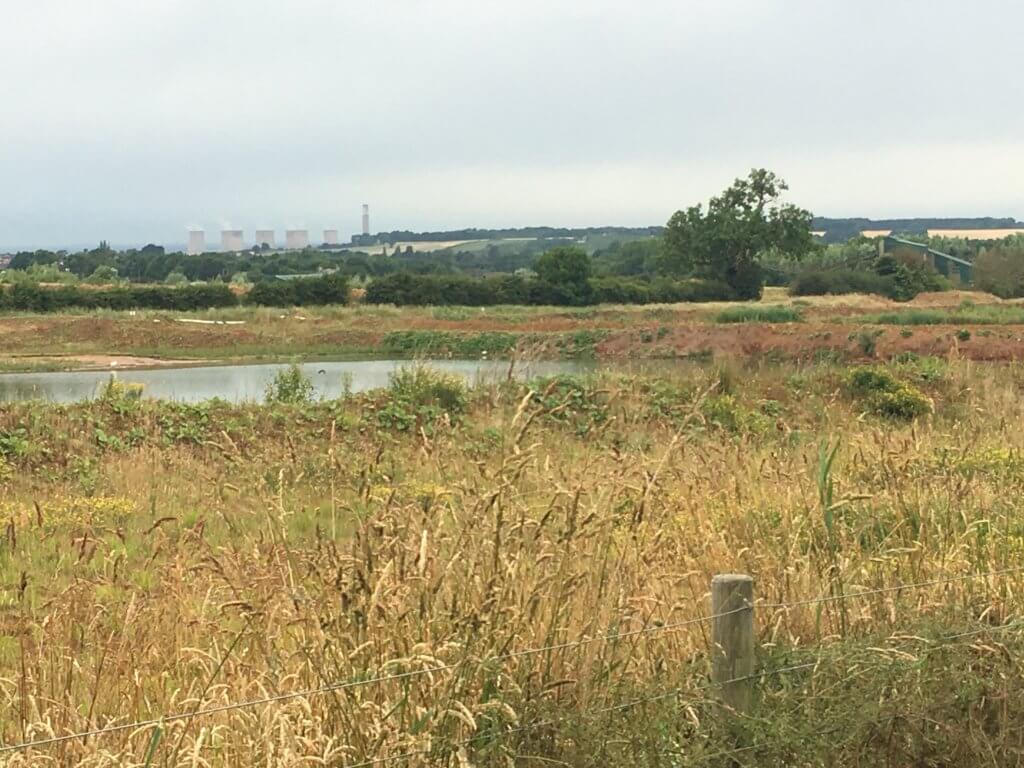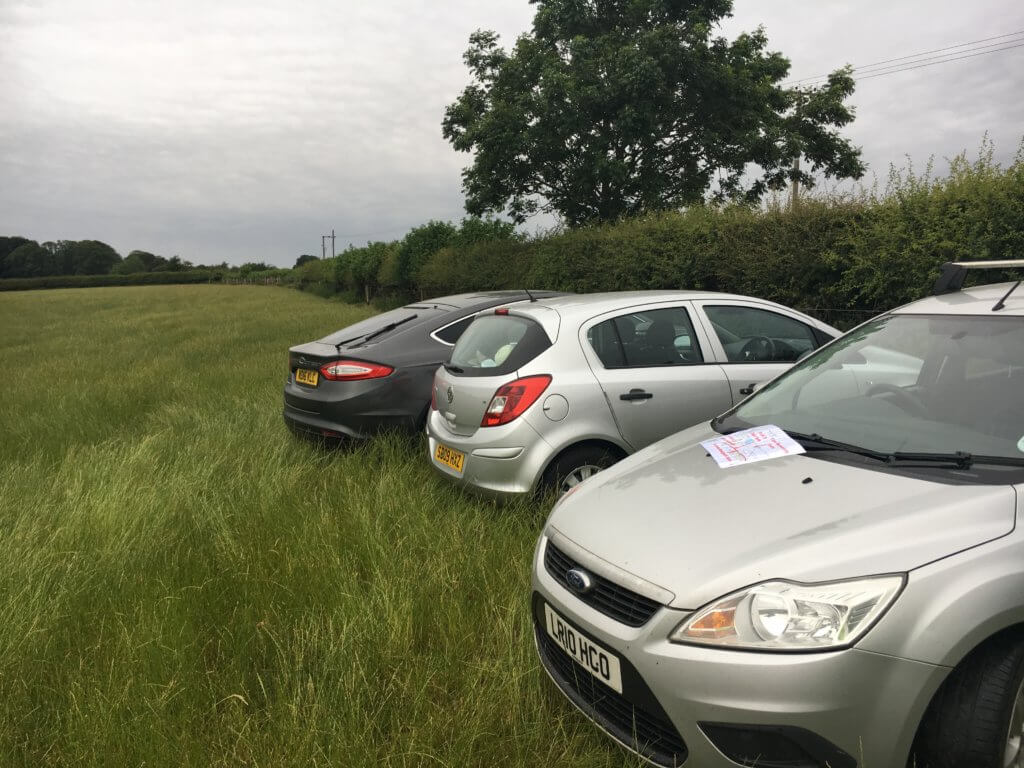
It doesn’t look like a particularly interesting part of the world – but it is now!
A gang of at least seven Bee-eaters have been found in rural Nottinghamshire, and the RSPB and CEMEX have set up, very rapidly, a viewing scheme. Good for them.
I was the second viewer there this morning just after the Today programme started on the radio and I was home and writing this blog before Today had finished – having seen three Bee-eaters.
Having studied Bee-eaters for many years, and not having seen them in the UK, I was quite keen to have a look at them. It wasn’t exactly Bee-eater weather this morning. I can imagine going back later in the year, and on a sunnier day, if they persist.
UK breeding records of Bee-eaters are accelerating in frequency. The ‘old’ records are of a pair at Musselburgh, Scotland in 1920 followed by three pairs near Plumpton, Sussex in 1955. This might suggest a fondness for nesting near racecourses but more recent records are from Durham (2002), Herefordshire (2005), Dorset (2006), Isle of Wight (2014) and Cumbria (2015) and now Nottinghamshire. Bee-eater records seem to be like darts thrown at the UK dart board by someone who needs to work on their grouping. All over the place!
At least these have picked the constituency of the Father of the House and birder Ken Clarke MP.
Can you think of another bird name which has four vowels in a row?


White Tailed Sea Eagle, Stellers Sea Eagle etc !
Dave – of course!
Blue-eared barbet.
Harry – very good!
Blue-cheeked Bee-eater…
Then there is Blue Eared Pheasant.
I have only seen one Bee Eater in the UK many years ago at Flamborough Head and have a couple of times missed relatively local migrants. I suppose I ought to have gone to Bishop Middleham to see them in 2002, not quite sure why I didn’t as it is a site I have visited several times to see orchids especially Dark Red Helleborine, for which it is by far the best UK site. I have however seen Bee Eaters in Spain, Poland and most memorably in September 2006 in Bulgaria when on one day many hundreds passed over us on migration as we stood in awe, the air full of calling swirling birds. One used to be able to hear them regularly on the Emmerdale sound track, I’m not sure whether that is still true as I haven’t watched it for years.
where have the like/unlike buttons on the main blog posts gone?
Never mind about clever spellings — the likes of Henry can eat four or more vowels in a row.
Try Hawaii. Kauaʻi ʻōʻō has six in a row.
Come to think of it, Hawaiian anything has four in a row 🙂
Sometimes Mark’s blog (engaging as it is) fails to see a bigger picture, or to fully grasp the importance of history. Lets pay tribute at East Leake Quarry, where tribute is due. Not just to the RSPB who have in essence parachuted in there within the last 48 hours, but instead (more importantly) to a dynamic local partnership at the quarry site between Nottinghamshire Wildlife Trust and CEMEX that goes back around 25 years, with a NWT member of staff linked to the site for 16 years. Sensitive conservation advice from the Trust, working in partnership with industry has created a wetland and sandbank system hugely attractive to a thriving colony of sand martins but also now 7 vibrant Southern European bee-eaters. This is what the Wildlife Trusts do best. Quietly but determinedly they establish working partnerships with landowners, industrial site managers and local people for the benefit of all, and nature. In the not so distant future, when extraction is complete, post-industrial East Leake Quarry will pass over to Notts Wildlife Trust as a local nature reserve which they will then manage with those valuable 25 years on site already in the knowledge bank. Now that is worth a nod in tribute and a ‘Good on them’, to quote Mark.
Rob – thanks for that. News to me, so thank you. But it’s not mentioned on Notts WT website, or is it? And a quick internet search fails to bring up these details so it seems like it’s a secret but I’m glad that the vice-Pres of NottsWT knows more about this than I do http://www.nottinghamshirewildlife.org/news/item/wildlife-trust-appoints-university-academic-as-vice-president-cementing-50-/
I was one of the Conservation Graziers at the NWT and I can confirm we have managed and grazed parts of the site for many years. Shame they are not getting the recognition due. RSPB again got in there ‘quick’ with this one
In 15 years of birdwatching at East Leake quarry (I found the Bee Eaters on Sunday and then alerted other local birdwatchers ) I’ve never seen Dr Rob Lambert or anyone else on site and neither have most of the quarry staff. Much of the site is due to be returned to the original owner to be turned into fishing pits.
If the sand Martin colony was so important to Notts Wildlife Trust they will be able to provide breeding counts or the last 10 years or so and counts of schedule 1 breeding species such as Little Ringed Plover . Why have so many of the Sand Martin banks from previous excavations been demolished the only reason the current ones exist is because they are the latest excavations ! I have plenty of pictures of East Leake quarry as it has evolved.
Credit to the RSPB for organizing he car parking that’s work well done! Credit where credits due.
David – thank you. I didn’t know I was starting a controversy.
How are the Bee-eaters? Still there? Still 7 of them?
Hi Mark
There are 4 today just been to watch from a different point as I have permission from the landowner.
I dislike propaganda that emanates from some conservation organisations when in fact they have done nothing.
Regards David
4 vowels in a row? Guillemot.
I don’t have satnav so could you tell me what road the car park is on? Lings Farm address appears to be Loughborough Road, but Google maps shows LE12 6RG to be on Ashby Road.
Linda – how about a ‘please’? It’s on Ashby Road – I approach from Wymeswold and Rempstone and it’s on the left after one gets into open country with no woodland either side. Sharp turn – be careful and indicate well in advance. Hope you enjoy them.
Thanks very much.